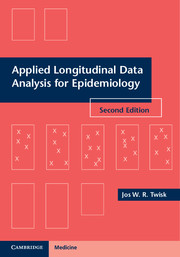Book contents
- Frontmatter
- Contents
- Preface
- Acknowledgements
- 1 Introduction
- 2 Study design
- 3 Continuous outcome variables
- 4 Continuous outcome variables – relationships with other variables
- 5 The modeling of time
- 6 Other possibilities for modeling longitudinal data
- 7 Dichotomous outcome variables
- 8 Categorical and “count” outcome variables
- 9 Analysis of experimental studies
- 10 Missing data in longitudinal studies
- 11 Sample size calculations
- 12 Software for longitudinal data analysis
- 13 One step further
- References
- Index
6 - Other possibilities for modeling longitudinal data
Published online by Cambridge University Press: 05 May 2013
- Frontmatter
- Contents
- Preface
- Acknowledgements
- 1 Introduction
- 2 Study design
- 3 Continuous outcome variables
- 4 Continuous outcome variables – relationships with other variables
- 5 The modeling of time
- 6 Other possibilities for modeling longitudinal data
- 7 Dichotomous outcome variables
- 8 Categorical and “count” outcome variables
- 9 Analysis of experimental studies
- 10 Missing data in longitudinal studies
- 11 Sample size calculations
- 12 Software for longitudinal data analysis
- 13 One step further
- References
- Index
Summary
Introduction
In Chapter 4, GEE analysis and mixed model analysis were introduced as two (sophisticated) methods that can be used to analyze the longitudinal relationship between an outcome variable Y and several covariates X. In this chapter, the models described in Chapter 4 (which are known as standard models) are slightly altered in order to answer specific research questions.
Alternative models
Time-lag model
It is assumed that the greatest advantage of a longitudinal study design in epidemiological research is that causal relationships can be detected. However, in fact this is only partly true for experimental designs (see Chapter 9). In observational longitudinal studies in general, no answer can be given to the question of whether a certain relationship is causal or not. With the standard models described in Chapter 4, it is only possible to detect longitudinal associations between an outcome variable Y and one (or more) covariate(s) X. When there is some rationale about possible causation in observational longitudinal studies, these associations are called “quasi-causal relationships.” In every epidemiological textbook a list of arguments can be found which can give an indication as to whether or not an observed relationship is causal (see Table 1.1). One of these concerns the temporal sequence of the relationship. When the covariate X precedes the outcome variable Y, the observed relationship may be causal (Figure 6.1).
- Type
- Chapter
- Information
- Applied Longitudinal Data Analysis for EpidemiologyA Practical Guide, pp. 103 - 118Publisher: Cambridge University PressPrint publication year: 2013
- 4
- Cited by



